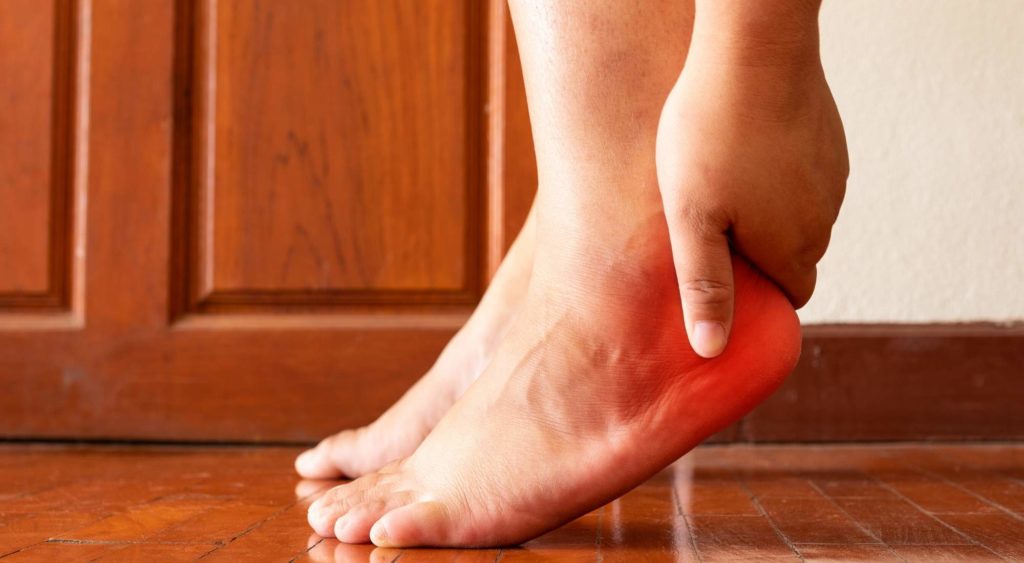Plantar Fasciitis Physical Therapy

Physical Therapy for Plantar Fasciitis – Information, Exercises, and More
You wake up in the morning ready to start the day.
As soon as your feet hit the floor, you feel a stabbing pain in the bottom of your feet.
This pain could be a sign of plantar fasciitis.
In this guide, we’ll go over the signs and symptoms of plantar fasciitis, as well as treatment plans to help reduce pain.

What is Plantar Fasciitis?
Plantar fasciitis refers to inflammation of the plantar fascia, a thick band of connective tissue on the bottom of your foot that connects your heel bone to your toes.
Plantar fasciitis pain typically occurs:
- During your first steps in the morning
- After long periods of standing
- Standing following long periods of sitting
- After walking or running
What Causes Plantar Fasciitis?
Plantar fasciitis occurs when too much tension and stress on the plantar fascia results in small tears in the tissue.
Some factors and activities can increase your risk of plantar fasciitis, including:
- Running/walking long distance. Plantar fasciitis is the most common running-related injury. Studies show that 5-18% of athletes suffer from plantar fasciitis.
- Age. As you get older, your plantar fascia begins to lose elasticity. People ranging in age from 40 to 60 are more vulnerable to plantar fasciitis.
- Obesity. Excess pounds can add more stress to the plantar fascia, causing inflammation and tears.
- Foot mechanics. Being flat-footed or having a high arch in your foot can put added stress on the plantar fascia. Abnormal walking and weight distribution while standing can also create added stress.
- Certain job occupations. Jobs that require you to stand or walk on hard surfaces for a prolonged period of time can increase your risks of developing plantar fasciitis.
Plantar Fasciitis Symptoms
The main symptom of plantar fasciitis is stabbing pain on the bottom of the foot, usually generating from the heel.
Pain typically doesn’t occur during exercise but worsens after exercise.
Although 80% of patients with heel pain are diagnosed with plantar fasciitis, it is important to rule out other causes of foot pain as well.
Plantar Fasciitis Treatment
If you have plantar fasciitis pain, you are probably looking for ways to alleviate it.
You can’t just quit your job to avoid being on your feet all day or put your life on hold because of plantar fasciitis pain.
The good news is there are many options available for plantar fasciitis treatment.
In most cases, patients can see improvement with conservative treatment like wearing specific insoles or shoes for plantar fasciitis and stretching.
Medications
Anti-inflammatory medications like ibuprofen and naproxen can relieve plantar fasciitis pain by decreasing the inflammation in the plantar fascia.
Therapies
Some therapeutic treatment options include:
- Physical therapy. A physical therapist can help you introduce stretches for plantar fasciitis into your daily routine for relief.
- Night splints. Night splints help stretch your calf and the arch of your foot to promote overnight stretching of the plantar fascia.
- Orthotics. Custom-fitted arch supports or specially made shoes for plantar fasciitis can help reduce pain when standing or walking.
Surgery and Other Procedures
When conservative treatment does not provide relief, more invasive procedures may be necessary
Some treatment options include:
- Injections. There are two types of injection treatments that can be used to treat plantar fasciitis.
- Steroid injections. This type of injection can be used to provide temporary pain relief to tender areas of the foot. It is not recommended to get multiple steroid injections, as this can cause your plantar fascia to weaken and risk rupturing.
- Platelet-rich plasma injections. These injections use your own blood to help promote tissue healing.
- Extracorporeal shock wave therapy. This treatment is usually used for patients with chronic plantar fasciitis that have not responded to other treatment options. This procedure aims to stimulate healing by projecting sound waves onto the affected area.
- Ultrasonic tissue repair. This treatment inserts a needle-like probe into the affected area to break up damaged tissue and suction it out.
- Surgery. Some patients may need surgery to detach the plantar fascia from the heel bone. This is the last resort when all other treatment options have failed and your pain is severe.
Plantar Fasciitis Physical Therapy – Will PT Help?
The answer is a resounding yes.
A physical therapist can equip you with a variety of therapeutic techniques to treat plantar fasciitis pain.
Aside from plantar fasciitis treatment, physical therapy can also help increase your ankle and foot mobility.
This can help correct weight distribution errors that could be triggering your plantar fasciitis when you are walking.
Best Plantar Fasciitis Exercises
Studies show that plantar fasciitis stretches and exercises were the best forms of treatment for 29% of patients diagnosed with plantar fasciitis.
Some of these stretches include:
- Leaning Wall Stretches — This helps loosen tightness in the calf and feet muscles, which can exacerbate plantar fasciitis pain.
- Ball rolling exercise — Ball rolling can help loosen the tension in your plantar fascia. This is a great exercise to try implementing before you take your first steps after waking up.
- Foot flexes — By flexing the foot, you can help increase blood flow to the foot and alleviate tension in the calves causing pain.
Completing plantar fasciitis stretches and exercises with the guidance of a physical therapist will ensure that you are using the correct form and will prevent you from accidentally causing further injury.
Speak with your doctor about a referral to a physical therapy center, like In Motion O.C.
How In Motion O.C. Can Help With Plantar Fasciitis
If you are suffering from plantar fasciitis, you are not alone.
As the #1 rated physical therapy clinic on Yelp! and Google, In Motion O.C. has helped hundreds of patients seeking plantar fasciitis treatment.
Don’t let plantar fasciitis pain slow you down. We are here to help alleviate your pain so you can continue your daily routines pain-free.
*This information about physical therapy for Plantar Fasciitis was reviewed by Dr Natalie Thomas, PT, DPT. If you have any questions, please don’t hesitate to contact us here.


